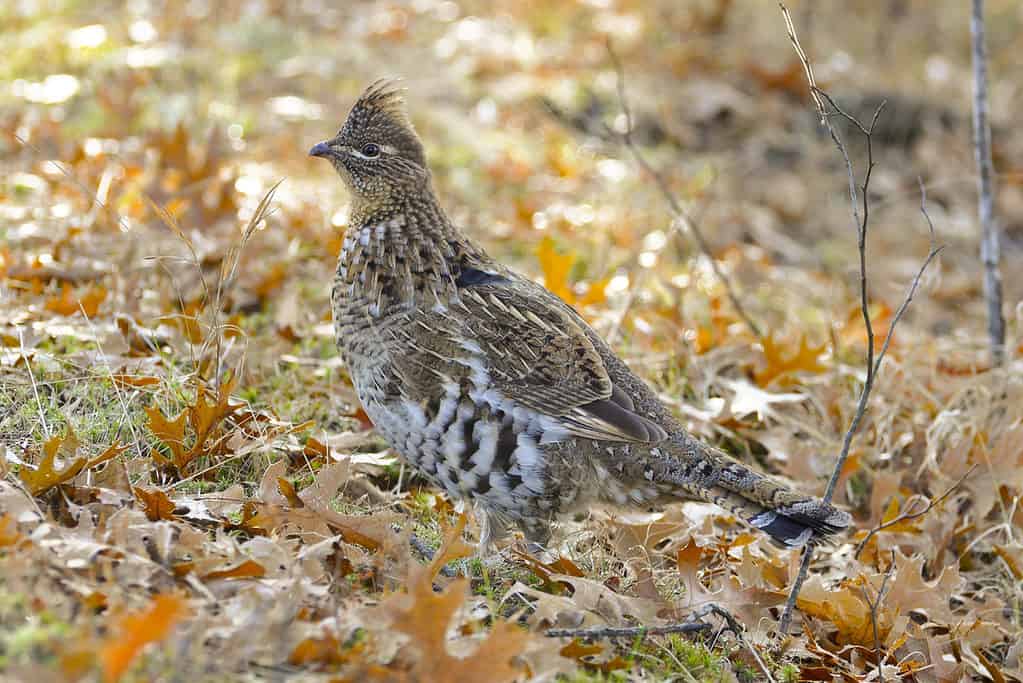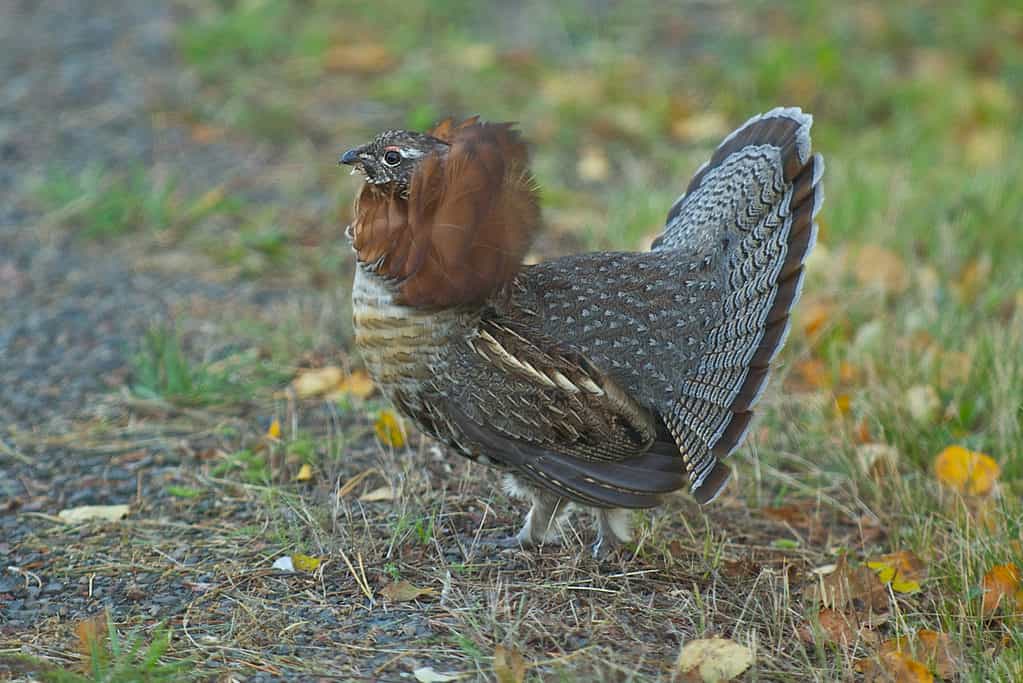In the heart of North America’s forests lives the ruffed grouse (Bonasa umbellus). One of the most widely distributed game birds in North America, the ruffed grouse is popular among hunters. But with its remarkable camouflage skills, this master of disguise isn’t a sitting duck. The male ruffed grouse is also a master of rhythm, presenting a drumming display that commands attention. Join us as we delve into the extraordinary world of the Ruffed Grouse: Habitat, Diet, Top Speeds, and More! We’ll discover that camouflage is an art form, drumming is a seductive symphony, and every encounter with this elusive creature promises to be an unforgettable adventure!

Female Ruffed Grouse standing on the forest floor on a frosty fall morning.
©iStock.com/SteveOehlenschlager
Taxonomy of the Ruffed Grouse
| Classification | Ruffed Grouse |
|---|---|
| Domain: | Eukaryote |
| Kingdom: | Animalia |
| Phylum: | Chordata |
| Class: | Aves |
| Order: | Galliformes |
| Family: | Phasianidae |
| Tribe: | Tetraonini |
| Genus: | Bonasa |
| Species: | Bonasa umbellus |
Ruffed Grouse: Appearance and Behavior
Ruffed grouse are medium-sized birds with a plump, chicken-like appearance. They can weigh upwards of 2 pounds (0.9 kg), and measure 20 inches (50 cm) in length. Ruffed grouse have wingspans of up to 25 inches (64 cm). Their mottled brown and gray plumage provides excellent camouflage in their forest habitat. A distinctive feature is the ruffle of feathers around their neck, which they can raise during courtship displays or when they’re feeling threatened. Their fan-shaped tail has a distinctive dark band at the top.
Though ruffed grouse are ground-dwelling birds, they hey can fly relatively short distances when needed, such as to evade predators and hunters. These birds are challenging to hunt thanks to their camouflage plumage combined with their ground-dwelling behavior. Male ruffed grouse use a drumming behavior, rapid, thumping sounds produced as they beat their wings against the air to attract females and establish territory.

Ruffed grouse are primarily ground-dwelling birds but can fly relatively short distances when needed, such as to evade predators and hunters.
©iStock.com/tmarko
Ruffed Grouse: Diet and Habitat
Ruffed grouse are principally herbivores, feeding on a diet of buds, leaves, fruits, and insects. In winter, they rely heavily on buds and twigs. They will supplement their diet with insects when necessary. They prefer a variety of forests, including young forests with dense cover, as well as mature forests with a mix of tree species. Ruffed grouse require habitats with a diverse understory and a supply of both food and cover. They are widely distributed throughout North America.
Ruffed Grouse: Reproduction
Breeding season typically occurs in the spring and early summer. The male’s drumming display is an essential part of courtship, attracting females to his territory. After mating, the female builds a shallow ground nest where she lays a clutch of eggs. The clutch will consist of 9 to 14 eggs. The female grouse lays one egg every 36 hours. The eggs will hatch in approximately 24 days after they are laid. Chicks are precocial, meaning they are born with their eyes open and can walk shortly after hatching. Unlike their parents, ruffed grouse chicks feed almost exclusively on insects. The average lifespan of a ruffed grouse is one year.

The male’s drumming display is an essential part of courtship, attracting females to his territory.
©Agnieszka Bacal/Shutterstock.com
Ruffed Grouse: Top Speeds
Ruffed grouse are primarily adapted for short bursts of flight to escape predators or navigate through their forested habitats. Their flight speed typically ranges from 20 to 40 miles per hour (32 to 64 kph). Their agility and ability to maneuver quickly through dense forest cover are more critical to their survival than sheer speed. If a ruffed grouse needs to make a quick escape or evade a predator, it can reach speeds of up to 55 miles per hour (88.5 kph) for short distances. This burst of speed allows them to rapidly change direction and navigate through the dense vegetation of their forested habitats. However, they can only maintain this speed for a very brief period before they tire, as their bodies are not adapted for sustained high-speed flight.
Ruffed Grouse: Conservation Status
The conservation status of the ruffed grouse varies by region and can be somewhat complex due to differences in population trends and habitat availability. However, on the whole, they are considered a species of least concern. Populations of ruffed grouse have experienced declines in certain regions, particularly in parts of the Northeastern U.S. Factors contributing to these declines include habitat loss and degradation, changes in forest composition, and climate change.
Habitat loss and fragmentation are significant concerns for ruffed grouse. They rely on a variety of forested habitats, including young forests with dense cover, as well as mature forests with diverse understory vegetation. Changes in forest management practices, urbanization, and agricultural expansion have reduced suitable habitat in some areas.
Climate change affects ruffed grouse indirectly by altering forest composition and making certain habitats less suitable. It can also affect the availability of food sources and increase the prevalence of diseases and parasites. Ruffed grouse are a popular game bird, and their populations are managed through hunting regulations. Wildlife agencies monitor populations and adjust hunting seasons and bag limits to ensure sustainability.

Ruffed grouse are a popular game bird, and their populations are managed through hunting regulations.
©David DeFillipo/Shutterstock.com
Ruffed Grouse: More!
- Though many folks refer to the ruffed grouse as a partridge, it is not a true partridge.
- Ruffed grouse snow roost. Once the snow is at least 10 inches (25 cm) deep, they will burrow into the snow and stay there until they get hungry. This behavior allows them to conserve energy.
- The ruffed grouse is the Pennsylvania State Bird
- One out of 2,200 ruffed grouse will live for eight years.
- Ruffed grouse chicks begin to fly at five days old. They resemble large bumblebees.
The photo featured at the top of this post is © iStock.com/tmarko
Thank you for reading! Have some feedback for us? Contact the AZ Animals editorial team.







